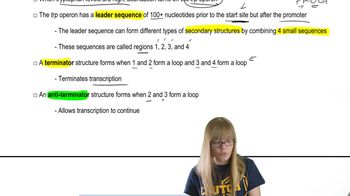Describe the role of attenuation in the regulation of tryptophan biosynthesis.
Table of contents
- 1. Introduction to Genetics51m
- 2. Mendel's Laws of Inheritance3h 37m
- 3. Extensions to Mendelian Inheritance2h 41m
- 4. Genetic Mapping and Linkage2h 28m
- 5. Genetics of Bacteria and Viruses1h 21m
- 6. Chromosomal Variation1h 48m
- 7. DNA and Chromosome Structure56m
- 8. DNA Replication1h 10m
- 9. Mitosis and Meiosis1h 34m
- 10. Transcription1h 0m
- 11. Translation58m
- 12. Gene Regulation in Prokaryotes1h 19m
- 13. Gene Regulation in Eukaryotes44m
- 14. Genetic Control of Development44m
- 15. Genomes and Genomics1h 50m
- 16. Transposable Elements47m
- 17. Mutation, Repair, and Recombination1h 6m
- 18. Molecular Genetic Tools19m
- 19. Cancer Genetics29m
- 20. Quantitative Genetics1h 26m
- 21. Population Genetics50m
- 22. Evolutionary Genetics29m
12. Gene Regulation in Prokaryotes
Tryptophan Operon and Attenuation
Problem 24
Textbook Question
The following figure depicts numerous critical regions of the leader sequence of mRNA that play important roles during the process of attenuation in the trp operon. A closer view of the leader sequence, which begins at about position 30 downstream from the 5' end, is shown below, running along both columns. Within this molecule are the sequences that cause the formation of the alternative hairpins. It also contains the successive triplets that encode tryptophan, where stalling during translation occurs.
Take a large piece of paper (such as manila wrapping paper) and, along with several other students from your genetics class, work through the base sequence to identify the trp codons and the parts of the molecule representing the base-pairing regions that form the terminator and antiterminator hairpins shown in the following figure.

 Verified step by step guidance
Verified step by step guidance1
Understand the context of the problem: The trp operon is a regulatory mechanism in prokaryotes, specifically in *E. coli*, that controls the synthesis of tryptophan. Attenuation is a process that regulates transcription termination based on the availability of tryptophan. The leader sequence of the mRNA contains regions that can form alternative secondary structures (hairpins) influencing transcription.
Locate the trp codons in the leader sequence: Carefully examine the provided base sequence of the leader region. Identify the triplets that encode tryptophan (UGG codons). These codons are critical because they are the sites where ribosome stalling occurs during low tryptophan levels.
Identify the regions that form the terminator and antiterminator hairpins: Look for complementary base-pairing regions within the leader sequence. The terminator hairpin typically forms when tryptophan levels are high, leading to transcription termination. The antiterminator hairpin forms when tryptophan levels are low, allowing transcription to continue.
Analyze the sequence to determine the conditions for hairpin formation: The terminator hairpin is usually followed by a string of uracils (U) and forms when the ribosome does not stall at the trp codons. The antiterminator hairpin forms when the ribosome stalls at the trp codons due to low tryptophan levels, preventing the terminator hairpin from forming.
Collaborate with your classmates to map the sequence: Use a large piece of paper to visually represent the leader sequence. Mark the trp codons and the regions that can form the hairpins. Discuss with your classmates how the sequence structure changes under different tryptophan conditions and how this affects transcription of the trp operon.
 Verified video answer for a similar problem:
Verified video answer for a similar problem:This video solution was recommended by our tutors as helpful for the problem above
Video duration:
35sPlay a video:
Was this helpful?
Key Concepts
Here are the essential concepts you must grasp in order to answer the question correctly.
trp Operon
The trp operon is a group of genes in bacteria that are involved in the biosynthesis of the amino acid tryptophan. It is regulated through a mechanism called attenuation, which allows the cell to respond to the levels of tryptophan. When tryptophan is abundant, the operon is turned off, while low levels of tryptophan lead to its activation. Understanding the trp operon is crucial for grasping how gene expression is controlled in prokaryotes.
Recommended video:
Guided course

Trp Attenuation
mRNA Leader Sequence
The leader sequence of mRNA is a short region at the beginning of the mRNA transcript that plays a key role in regulating gene expression. In the context of the trp operon, this sequence contains specific codons for tryptophan and is involved in the formation of secondary structures, such as hairpins. These structures can either promote or inhibit the continuation of transcription, depending on the availability of tryptophan, making the leader sequence essential for the attenuation process.
Recommended video:
Guided course

Sequencing Difficulties
Hairpin Structures
Hairpin structures are formed when complementary sequences within a single strand of RNA base-pair with each other, creating a loop. In the trp operon, the formation of alternative hairpins in the leader sequence determines whether transcription will continue or terminate. The presence of a terminator hairpin signals the RNA polymerase to stop transcription, while an antiterminator hairpin allows transcription to proceed, illustrating the dynamic regulation of gene expression.
Recommended video:
Guided course

Ribosome Structure
Related Videos
Related Practice
Textbook Question
852
views


